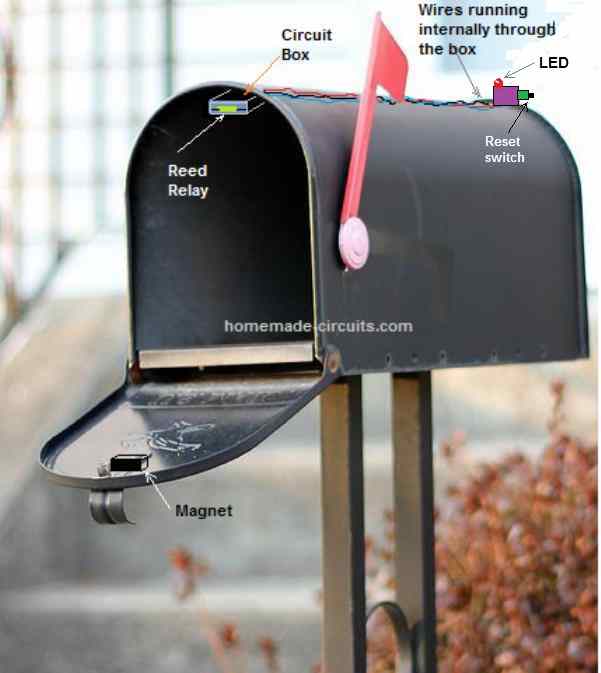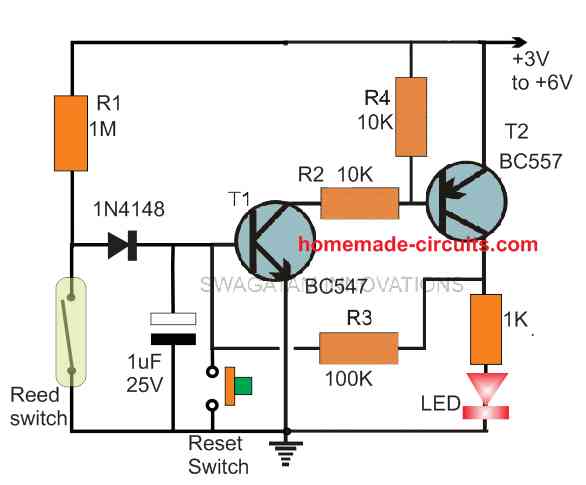In this post I have explained how to build a letter box open indicator circuit, which indicates through an LED if the letter box had been opened either by the postman, or by somebody else!
The idea was requested by Mr. Bill.
I wonder if you could help me.
I want to make an LED indicator to show whenever my mailbox has been opened.
What I have in mind is a simple battery circuit with a microswitch in the letterbox that triggers the LED and reset button on the outside. This should be easy but I’m not sure how I can make the LED stay on until I push the reset button?
Any advice or pointing to an existing product would be very helpful.
Letter Box Set up
The following figure shows the set up configuration of the letter box, in which the various electronic units and their placements are depicted.

In this set up we have used a reed switch and magnet arrangement for switching the circuit instead of a micro-switch, for ensuring higher working efficiency, and minimum wear and tear of the system. Nevertheless, if a microswitvh is preferred, the reed switch could be simply replaced with a microswitch for getting the same operational features.
The magnet can be seen glued to the inner top edge of the letter box lid, while the reed relay is positioned at the top inside portion of the letter box, in such a way that when the lid is closed the magnet comes face to face and at a close proximity to the reed relay.
The reed relay terminals are configured with an electronic latch circuit which includes an LED for the indicating an opened letter box situation.
When the lid of the letter box is closed and the reset button pressed, the magnet keeps the reed relay contacts closed and the circuit goes into a standby mode. The LED remains shut off in this situation.
Now, if the lid of the letter box is opened, the reed relay contacts release, causing the connected circuit to latch up, and the LED illuminates. In this position even if the lid is closed again, the LED continues to be in the switched ON condition, indicating the owner regarding an previously opened letter box.
The LED can be shut off only by pressing the reset button, with the letter box lid in the closed position
How the Circuit Works
The following figure shows the part configuration for making the letter box open indicator circuit. The design is basically a transistor latch circuit using a couple of transistors with a feedback loop for the latching.
The working procedure of the circuit could be understood with the following points:

Basically, since it is a latch circuit, the circuit will switch ON the LED and get latched as soon as power is switches ON.
When power is switched ON, the transistor T1 is triggered ON through R1, which switches ON T2, and the entire system gets latched via the feedback resistor R3.
In this situation, even if the R1 connection is removed, the transistor would still remain latched and the LED will continue to remain illuminated.
For our letter box open indicator application we want the LED to be switched OFF while the lid of the box is in the closed position, and once it is opened only then the LED should go into a permanently ON position regardless of whether the lid is closed back or not.
For this, we have employed a reed switch, or reed relay whose contacts remain open in the absence of a magnetic field and the contacts close when a magnet is brought near the reed switch device.
As depicted in the previous letter box figure, the circuit is initiated by keeping the lid of the letter box closed, which causes the magnet to reach very near to the reed switch so that its contacts now close.
Next, power is switched ON to the circuit.
However, in this situation the latch is unable to operate because the reed switch contacts ground the base of T1. If T1 cannot switch ON, T2 also cannot switch ON, and the entire latching system remains deactivated.
Now, if the letter box is opened, the magnet is pulled away from the reed relay, causing its contacts to open.
When the reed switch contacts open, it removes the grounding of the R1 base current, enabling the switching ON of transistors T1, T2, and the entire system latches ON via R3.
The LED now illuminates indicating that the letter box had been opened by somebody.
In this situation, even if the letter box lid is closed, causing the reed relay contacts to close, and R1 current to become zero, that does not break the latch, since the T1 base keeps getting the biasing current via R3.
The LED now turns permanently ON, until the owner of the letter box presses the hidden reset switch.
The reset switch grounds the feedback latching current via R3 and cuts off the supply to T1 base which ultimately breaks the latch, switching OFF the LED.
However, this resetting must be done with the letter box lid in the closed position (reed relay open). The resetting function will not work if the lid of the letter box is in the open position.
Using a Microswitch
If you prefer using a microswitch instead of the reed relay, you can simply replace the reed relay with the terminals of the microswitch for enabling the same operations, as discussed in the above paragraphs.
In this case, the magnet will not be required, and the micro-switch can be positioned in such a way that when the lid of the letter box is closed, it presses the micro-switch into a switched ON condition.